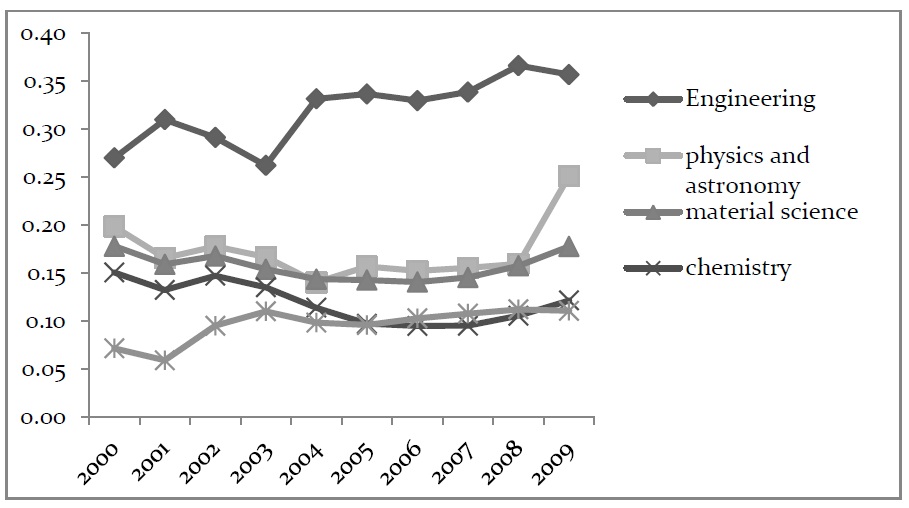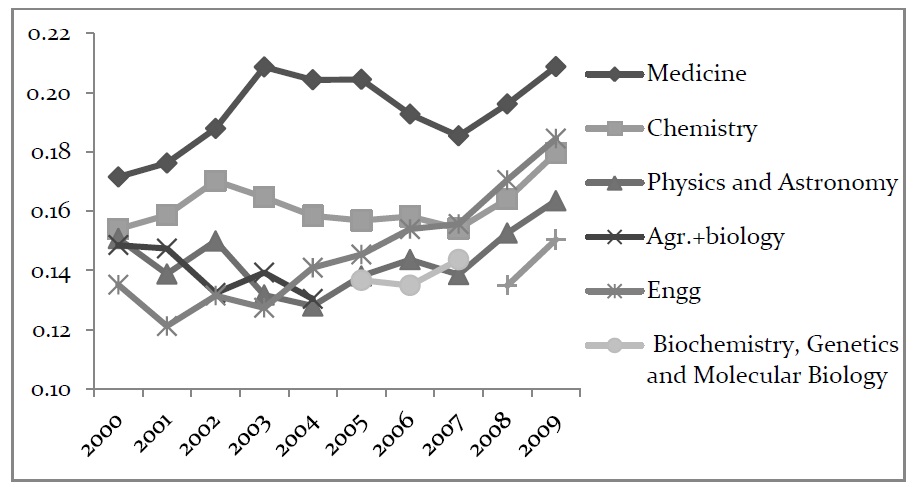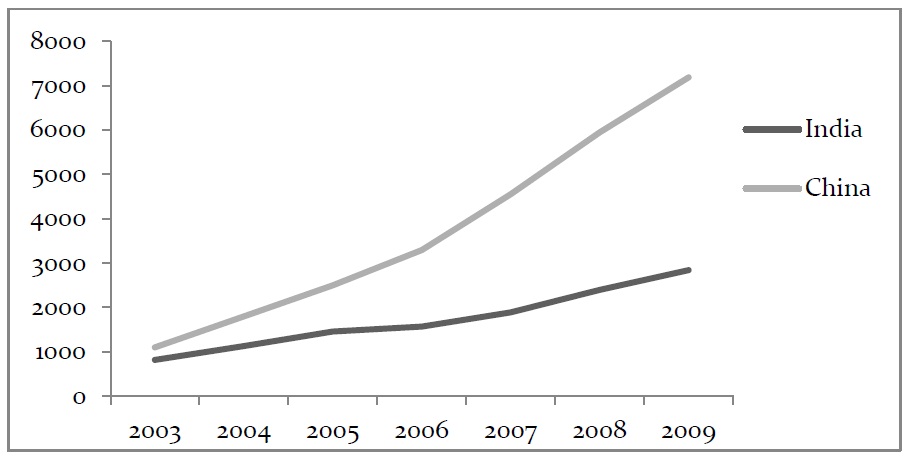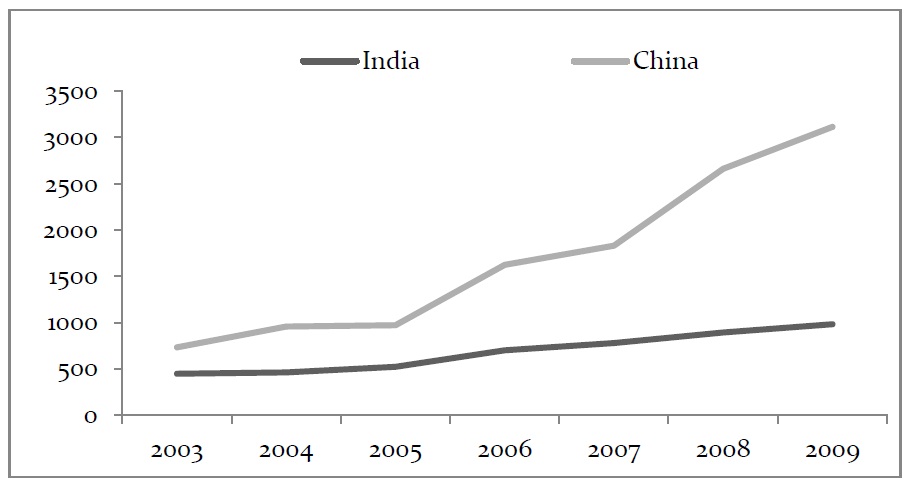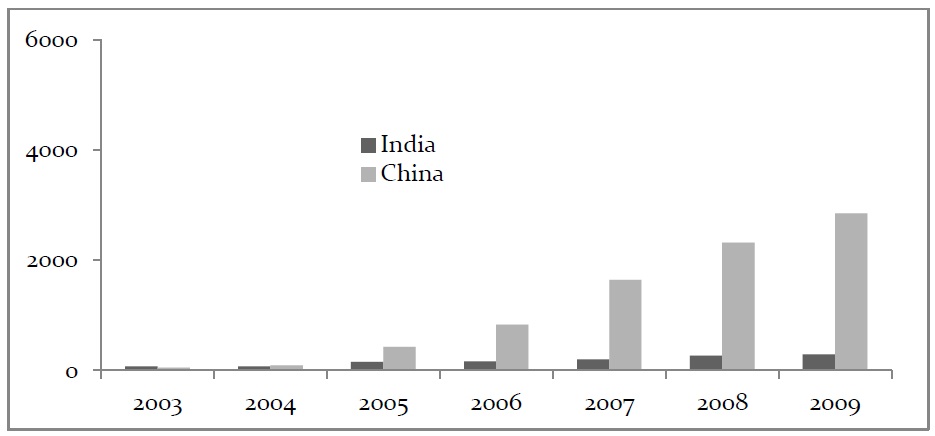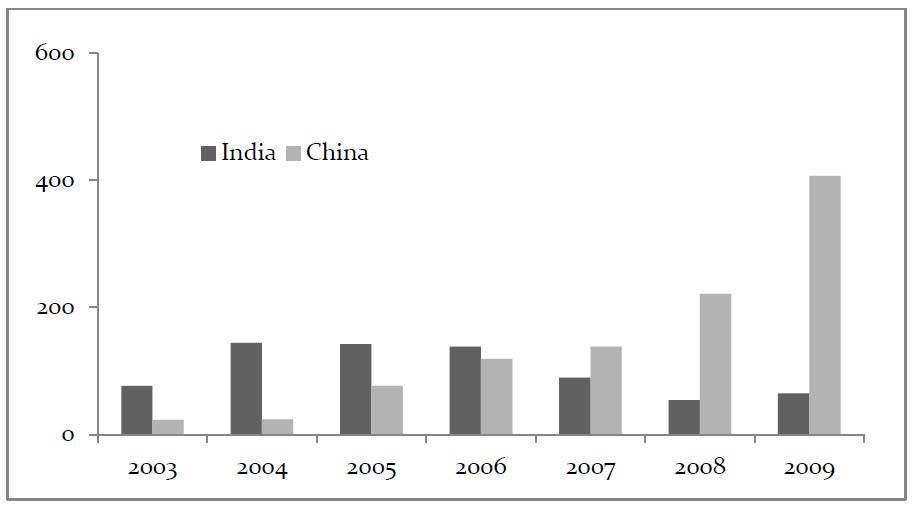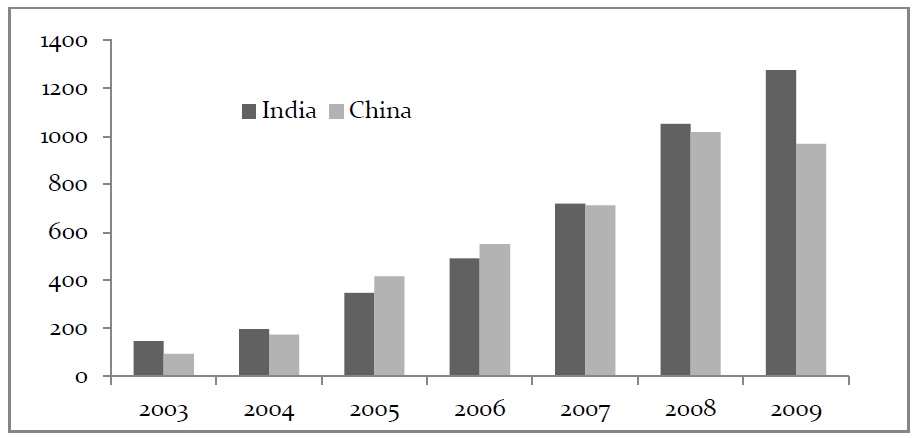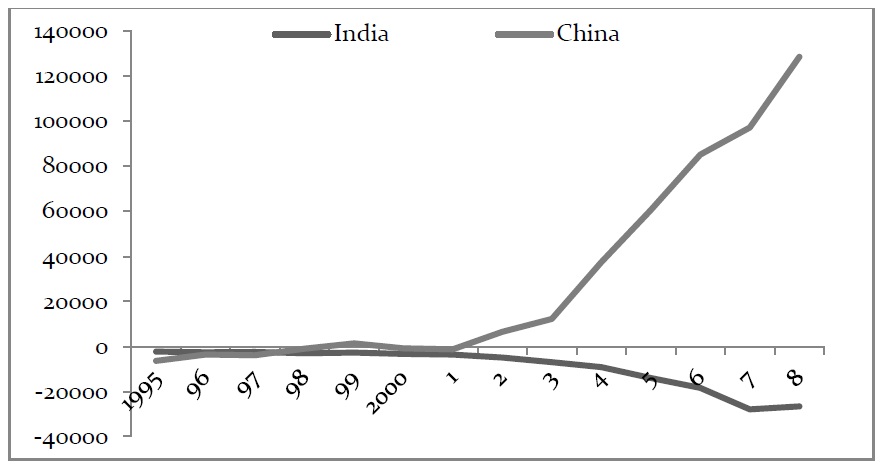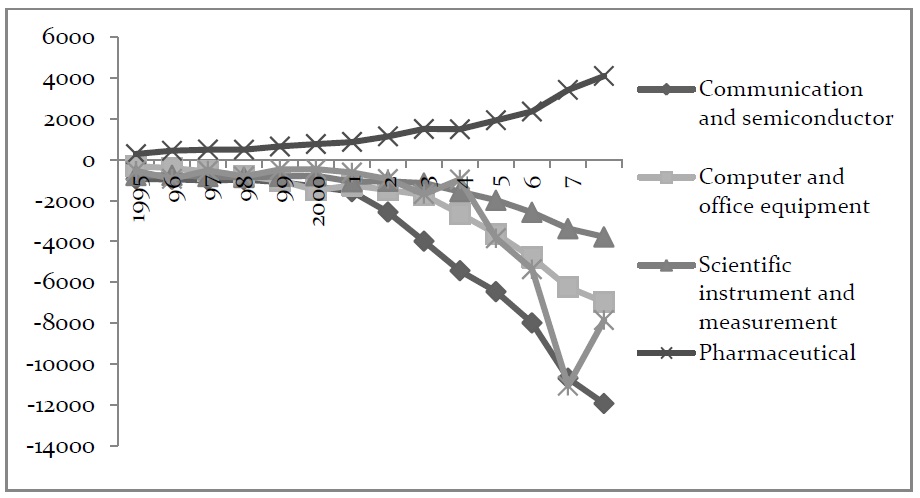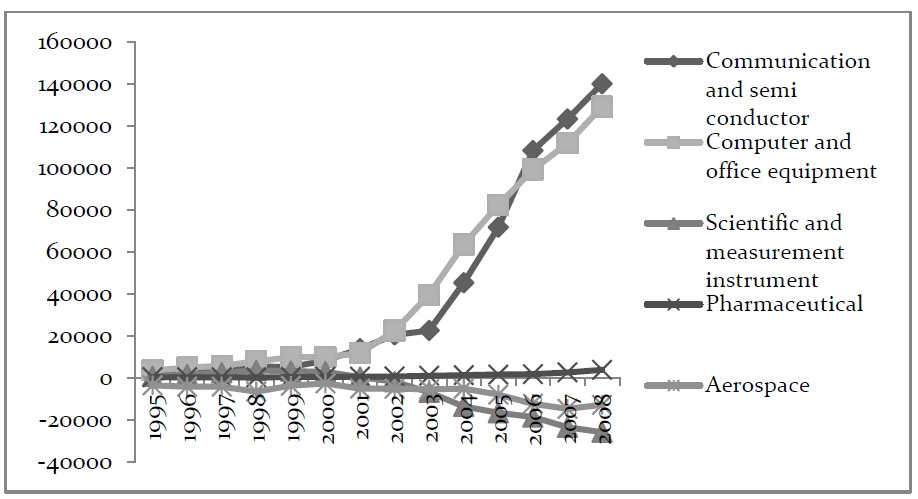



In the past three decades since the advent of market oriented reforms began in 1978, China has made rapid strides in catalyzing economic growth. The economic development coincides with the development of significant capabilities in several areas of science, technology, and innovation. China has recorded notable achievements in a number of emerging fields. This paper investigates the process that has catalyzed the developments in Science and Technology (S&T) and the key factors that have facilitated this process. The causality of dynamism of S&T in China points at targeted development, an emphasis on high growth industries and high technology, commensurate resource mobilization, ruthless restructuring of innovation actors, dynamic organization and management of R&D, continuously evolving policies with strict enforcement, and implementable instruments. This paper attempts to bring out the roadmap of the Chinese transformation process in S&T and derive policy lessons for India.
One of the most significant changes in the global economy of the 21st century is the emergence of China as a major economy. This economic development coincides with the development of significant capabilities in several areas of science, technology, and innovation. China has made technological advances in key sectors, such as aerospace, nanotechnology, biotechnology, information technology and telecommunications, pharmaceuticals, and the automotive industry (Preeg, 2008). China has narrowed down the scientific gap with developed countries and even managed to leave them behind in certain technology groups. What China has accomplished in the last three decades in terms of growth and development is not as important in terms of its quantum as it is in terms of the adoption of processes and frameworks. This paper investigates the process that has catalysed developments in Science and Technology (S&T) in China and the key factors that facilitated this process. The intent is to identify various issues that triggered transformation.
While commendable achievements have been made in India in areas such as space, atomic science and technology and defence related technological innovations; Indian industries and R&D/innovation systems have not performed at the global level of efficiency. The exceptions in this case are sectors such as pharmaceuticals, information and communication technology services, and automotives. This paper delves into the roadmap followed by China to foster S&T and catalyse innovation through its policies. Comparisons are made with India in order to draw parallels and seek out lessons.
The section following the Introduction deals with the assessment of the performance of China and India through selected standard input-output indicators and global knowledge and innovation indices.
Section 3 offers an evaluation of S&T and innovation policies in the period following market reforms in China that provide the base for the roadmap of the process of building up S&T and innovation capabilities. Section 4 concludes the paper by suggesting lessons that can be drawn for India.
II. An Assessment of the Performance of China and India in S&T & Innovation
A comparison of the Knowledge Economy Index (KEI)1 of China and India in 2000, 2009 and 1995 is given in Table 1. This index – based on parameters related to economic incentives and institutional regime, education, innovation, and Information and Communications Technology (ICT) – shows that China has consistently improved its performance on innovation and education vis-a-vis India during the three time periods (Table 1). China’s education index is almost double that of India.
[Table 1] Knowledge economy index (KEI) for China and India

Knowledge economy index (KEI) for China and India
Global Innovation Index2 (GII), which is a measure of the suitability of conditions in an economy to sustain innovation, ranked China 29th and India 62nd in the world in 2011. The relative position of both these economies on the indices of human capital and research ranked China at 56th and India at 104th place in the world. In terms of scientific outputs, China was ranked at 9th and India at 60th place.
[Table 2] R&D as a percentage of GDP in India and China

R&D as a percentage of GDP in India and China
Let us look at the R&D investment for both countries. Chinese investments in R&D as a percentage of GDP were at par with India prior to 2000 but increased by 161% by 2011. China’s increase has been more than 20% each year while India has hardly been able to push the figures up (Table 2). Trends in OECD countries show that once the R&D/GDP ratio reaches 1%, it rapidly increases to 2. In terms of gross R&D expenditure, China is now the second largest country behind only the USA. China spent $154.14 billion on R&D in 2009 (NSB, 2012). According to the Battelle forecast, China’s R&D spending will match and surpass that of the USA by 2023 (Battelle, 2011).
The two main output indicators of research performance are the number of papers published and patents granted. While publications are broadly considered to be the output of scientific pursuits, patents are used for assessing the relative strengths in technology and knowledge generation. Another indicator that we have used here is high technology exports, which is a reflection of the technological capabilities of a nation’s industry in translating S&T capabilities into production systems for economic gains.
Table 3 shows the total scientific publications of China and India between the years 1990 and 2009. China surpassed India in the period between 1990 and 1995 by doubling its publications and by 2009, China’s publications became five times that of India.
[Table 3] Total publications from 1990 to 2009
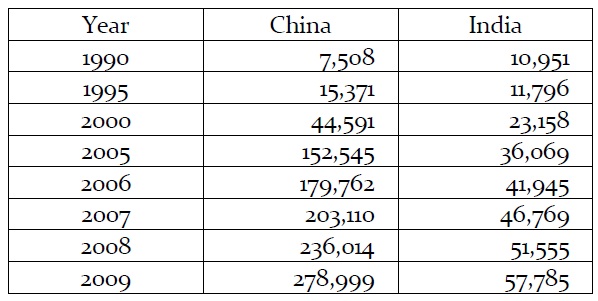
Total publications from 1990 to 2009
The fields in which both countries have been active in publishing are shown in figures 1 and 2. The share of the top five S&T disciplines in China shows that engineering disciplines constituted as high as 35% of the total publications in 2008. The emphasis on manufacturing by China drives the higher output in engineering discipline. The other active fields are physics and astronomy, material science, and chemistry and medicine.
In contrast, the Indian case shows a different picture with a smaller distributed share in several fields. Medicine occupies the highest share and engineering occupies the second position along with chemistry since the middle of the 2000s. Material science finds a place among the top seven since 2008.
Patenting activities constitute a very important component of the innovation activities of an economy. The United States Patent and Trademark Office (USPTO) considers it a good measure of the innovative activities of any economy. China has shown a consistent increase in the number of patent applications and patents granted between 2003 and 2004 (Figures 3 and 4). In contrast, the patenting activity in India shows a very nominal increase in India during the same period.
The patent outputs of China and India in some specific technology groups from 2003 to 2009 is given in Table 4. The data on patents for both China and India reflect a higher increase in the case of China in nine out of ten technology groups.
[Table 4] Comparative performance of India & China in high technology patents
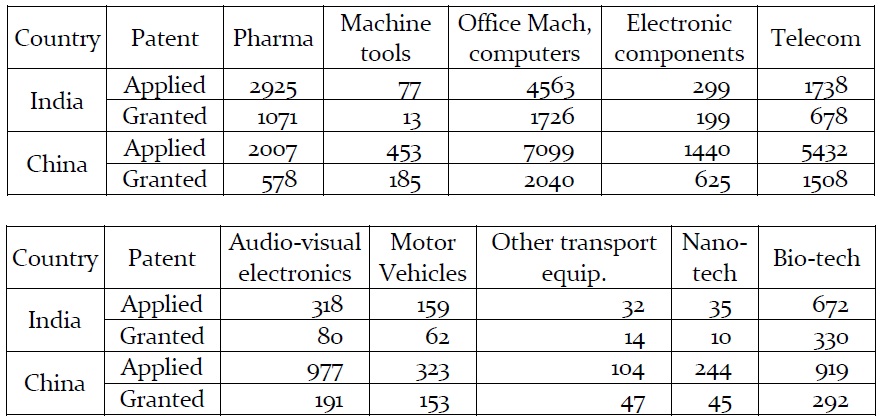
Comparative performance of India & China in high technology patents
The share of patent applications by the type of applicants such as domestic firms, research organisations, or MNCs for both India and China is shown in Figures 5,6, and 7. Chinese domestic firms are more active in comparison to Indian firms in patenting (Figure 5).
The case of domestic research organizations in China, although not very spectacular in terms of absolute number of patents, yet reflects a continuously increasing trend. India, on the other hand, shows a declining trend which raises some concerns particularly in view of the fact that three fourths of R&D in India is accounted for by the government (Figure 6).
Both China and India have been projected as most preferred destinations for carrying out R&D by Multinational Corporations (MNCs) for their global operations. Do they show similar propensities in patenting? India has been ahead of China since 2003 in patenting activity by MNCs (Figure 7). The trends are suggestive of India emerging as the more preferred destination in comparison to China by MNCs for their R&D operations.
High technology exports are used as an indicator of technological competitiveness and result from the amalgamation of high-tech production as well as export capabilities (Porter, et al., 1996). It is basically a reflection of the ability of an economy to derive value from activities which are R&D intensive. How have China and India fared in high technology exports to the rest of the world? Figure 8 shows the balance of trade (in million USD) for both countries from 1995 to 2008. While China managed to wipe out the deficit by 2001, India faced an increasing trade deficit in high technology export and import.
An elaboration on the scenarios for both countries in five important hightech areas, such as communication and semiconductors, computers and office equipment, scientific instruments and measurement, pharmaceuticals, and aerospace can be seen in Figures 9 and 10.
India has an increasing negative balance in all areas except pharmaceuticals, which has shown a positive balance of trade.
China has shown high growth in both —the area of communication and semiconductors and in that of computers and office equipment.
The exemplary performance of China in high technology exports has been criticised on account of the fact that the major contributors to these exports are MNCs (Cao, 2004). Another criticism is that of the operation of exporting Chinese firms at the lower end of global value chains. However, one cannot deny that China has now been integrated in to the global production system. It is also seen that even though MNCs have contributed much to exports, Chinese firms from high technology zones have also begun to play a significant role in the exports.
In the following section, the above data trends are interpreted in the context of Chinese policies on S&T and innovation.
Both China and India opened up their economies gradually; though China proved to be ahead of India in the process. The basic difference between China and India was that China began its export drive much earlier and also pushed manufacturing. In contrast, exports came to dominate the Indian scene much later and manufacturing did not receive the required attention.
Even though India led in the number of publications in 1990, it was overtaken by China by 1995. The increasing output of papers published by Chinese researchers was also accompanied by an increase in key citations in international citation indices in information technology (IT), life sciences including pharmaceuticals, medical devices and biotechnology, electronics, nanotechnology, environment, and energy. China has shown growth in a few key areas, which are the declared priority areas designated by the Chinese Government. The priority areas are similar to the prioritisation followed in the OECD countries (Battele, 2010). China has made notable achievements in clean energy, supercomputing, nanotechnology, advanced materials, etc. For instance, in nanotechnology China has now outpaced the US in terms of the output of publications and has been an active participant in standards development (Bhattacharya, et al. 2012). China has recorded notable achievements in a number of emerging fields such as protein, genomics, etc. Similarly IT, which influences several industries due to its broad range of applications, has remained a consistent priority in China. China’s R&D in supercomputing is proving to be tough competition to the US. Indications are that this could become true for all processing devices manufactured in China (Battele, 2010). China has used a judicious mix of hardware and software3 in the IT sector with a target oriented approach. In the field of supercomputing, China’s National University of Defence Technology developed the Tianhe 1 in 2009 made with processor chips made by US companies. This was replaced by the Xinguan in 2010. The speed of the Xinguan was double that of the Tianhe 1 and was developed by the Chinese Academy of Science (CAS) in collaboration with another company. The Xinguan was toppled by the Japanese K computer, but Chinese efforts unveiled an even faster computer in 2011, the Sunway Bluelight MPP built with a Chinese microprocessor chip4.
Similarly in clean energy, China is gradually outpacing the USA through a comprehensive strategy focussing on research as well as manufacturing. The emphasis on clean energy is discernible in almost all major national programmes. A well developed, long-term strategy of consistent and increased investments in clean energy has enabled China to garner clean energy supremacy over its rival countries, even if they have been pioneers in the development of solar PV, wind, and nuclear power technologies. China has, however, managed to strategically acquire much of the ensuing gains. The government of China plans to invest a total of $417 billion in domestic clean technology industries in contrast to $172 billion by the United States5.
China has shown consistent improvements in S&T performance in terms of outputs from academia and government research institutions. Domestic enterprises have shown gradually increasing patents output. There is a very distinct increase in Chinese global trade activities in select fields. These issues raise very important questions in terms of the roadmap chosen by China and strategies adopted.
1 KEI reflects the suitability of the environment for using knowledge for economic development.
2 Global Innovation Index, 2011 (http://www.globalinnovationindex.org/gii)
III. Roadmap of China’s Transition: A Systematic Coupling of S&T, Innovation and Economic Policies
The Chinese model of development, like the Japanese and Korean models, has been a specialization in selected sectors, targeting high growth industries. An emphasis on manufacturing and exports and enhancing the technological component of its exports, the promotion of the innovation actors, massive R&D investments and protection of the domestic producers have also been highlights of the Chinese model. Science and Technology was visualised by the Chinese government as an enabling factor that would aid production along with labour and capital.
Though China still has a long way to go in creating breakthrough technologies, its reliance on R&D in select fields has enabled it to narrow the knowledge gap with the leaders of the field. China has consistently improved its rankings in selected fields. This can be attributed to its target-centric approach.
The following emerge as the key points that summarize Chinese initiatives to manage and co-ordinate its S&T aspirations towards industrial development and help leverage innovation in China.
1. Visionary, State-directed, and targeted development with appropriate policy concurrence between economic and innovation policies
2. Appropriate resource mobilization: Reforms in the higher education sector, government R&D institutions, and strengthening the ecosystem of innovation
3. Organization and management of R&D and technology
One of the defining features of the rise of S&T in China post reforms is the highly interventionist role of the government in using S&T as a complement to economic transformation. The vision of S&T based development and the narrowing of the knowledge gap with developed countries formed the foundation of the policies. S&T was considered crucial to support production along with labour and capital. Another central issue underlining the rise of S&T is China’s approach to the whole system of policy making and implementation supported by the tight governance of S&T. China displays an unmatched execution of the conversion of political aspirations into action plans through adroitly crafted strategies. These are further operationalized by a large number of policy instruments. China’s S&T and innovation policies have played an important role in its transformation as is evident in its transformed S&T infrastructure and S&T capabilities (Sandhya et al., 2012).
An important question concerning China’s enhanced S&T capacity and capabilities is how it managed to achieve these heights in spite of having inherited a Soviet model of S&T that was marred by several deficiencies. The dismissal of the Soviet model proved to be an important turning point in the Chinese S&T system, which was plagued by basic defects and was a closed one. This existing S&T system suffered due to a lack of horizontal linkages with education and business and an inability of the structure to facilitate technology diffusion due to a lack of Intellectual Property Rights (IPR) or mechanisms of technology transfer. There were also hindrances for private initiatives in scientific enterprises due to direct interventions from the administration, and a dampening of enthusiasm and creativity of R&D personnel due to the rigid structures of research institutes (Xin, 2010; Yuan 2005). A series of organizational and structural changes were introduced to revamp the S&T system including research institutes and universities. Reform measures implemented by the leadership included dismantling the old unproductive structures, restructuring and creating new institutions. China implemented a multifaceted S&T policy through strategic national programmes with the aim of boosting its S&T capabilities and to catch up with the world. These programmes dealt with basic research, applied research, innovation, human resource, and so on and so forth with the aim of catching up with the world.
Post 1990, there was a surge in implementation of measures related to the issue of human resource generation and augmentation. In the period beginning 1998, Chinese policy making shifted its concerns to the National System of Innovation and the Knowledge Economy.
The major policy decisions which charted China’s overall direction for orienting S&T and laid a framework for S&T have emerged from the National S&T conferences held in 1985, 1995, 1998 and 2006 from which the strategic decisions evolved. These exercises helped in providing overall direction for orienting S&T and laying down the framework.
The Chinese government’s 1985 Decision on the reform of the science and technology management system adopted a multipronged approach to revamp the management and financing of S&T. The Decision was also aimed at the commercialization of research results, linking up various stakeholders of S&T, the judicious deployment of resources, management of S&T personnel, autonomy, and the opening up of S&T to the outside world. This was followed up by the 1995 Decision, which took the measure to a higher level. The underlying consideration was that science and technology must contribute to economic development. The 1995 Decision strengthened the link between research and industry, and between technology imports and indigenous innovation. The focus was shifted to human resource. These were also accompanied by a number of national programmes with massive investments. China’s growth strategy, as reflected through its policy trajectory, has unfolded in stages. It has displayed an innovation plan in which strengthening of innovation has been strategized gradually with both a medium and a long-term focus. China has boosted investments in S&T and also taken steps to build its National Innovation System by enacting various policies and laws in its ongoing transition to an innovation-based economy. By the year 2002, China had issued over 500 policy recommendations dealing with science, technology, and innovation; of which tax policies accounted for about 25% of total S&T policies and laws (Rongping, 2004).
Some key features that characterize the Chinese policy architecture can be summed up as the following: First, since the basic agenda of the Chinese Government post-reforms was to catch up with the developed countries and to reduce the gap between them, R&D efforts were intensified in select areas, and high technology R&D was used as a complement to competency building with a target-centric approach. Second, the jurisdiction of Chinese S&T and innovation policies covered the entire innovation infrastructure including research institutions, universities, S&T Parks, support structures, etc. Emphasis on the promotion of basic research, applied research, and high technology and innovation unfolded gradually in the subsequent strategic plans. Third, a commonality of priority areas is seen in national programmes across the entire innovation chain. There is connectivity and consistency in chosen focus areas. This has helped in the consolidation of specific sectors and technology groups. Fourth, initiatives to strengthen research have been adequately supported by resource initiatives for both human resource generation as well as augmentation. Fifth, there is timely implementation, rigorous monitoring and evaluation of the key policy initiatives (Sandhya et al., 2012). Sixth, some of the major national programmes, such as 863, Torch Programme, key technologies programme, etc., are financially very well endowed. Lastly various policy interventions on standards, intellectual property, indigenous innovation, etc. have helped in boosting the innovation ecosystem.
2. Appropriate Resource Mobilization
In order to mobilise resources, China targeted the transformation of not only the actors of innovation – such as educational and research institutions – but also by strengthening the ecosystem of innovation. Together, these formed the core of S&T and innovation policies in China.
2.1 Reforms in the Higher Education Sector
The transformation and modernization that has taken place in China is a combination of a realization of the damage done to its human resource because of earlier policies and a will to undo the damage. Since the beginning of reforms, corrective measures have been undertaken to carry out the ambitious task of reviving the education system and generating adequate human resource. China has undertaken a series of reforms to modernize and invigorate its education system. China gave high priority to its education system in primary, higher education, and vocational education. In order to revamp human resource, China engaged in generation and augmentation, targeting global excellence in key areas in selected universities, and the formation of global universities. Initiatives were also taken to attract skilled manpower through repatriation for both universities and research institutions in order to augment human skills, enhance the stock of PhD manpower, etc. Some of the outcomes of these reforms have been: an increase in the enrolment in tertiary education from 5 million to 23 million; an increase in participation for the 18-22 age bracket from 10% to 22%; an expansion in the number of tertiary institutions from 1,054 in 1995 to 1,731 in 2004; and an increase in the number of researchers by 77% between 1995 and 2004. This has elevated China to the second position in the world rankings behind only the USA (OECD, 2008).
Apart from organizational restructuring, enhancing university industry linkages by encouraging the universities to get into commercial activities by allowing universities to own up affiliated firms has also been one of the major reforms. China also created university spin offs, which has helped create a culture of commercialization of R&D. A number of programmes have been launched for the generation of manpower, modernization of universities, repatriation of Diaspora, and so on and so forth (Table 5). Some of these initiatives such as the One Hundred Talent Programme; the Cheung Kong Scholar Programme; the Hundred, Thousand, and Ten Thousand Talents Programmes; the Chunhui Programme, etc., have targeted human resource augmentation through repatriation (Table 5). Project 211 was launched to revamp the higher education system by strengthening around 100 educational institutions and key disciplinary areas. The impact of this initiative was enhanced R&D productivity in selected institutions. The 985 Project targeted transformation in a limited number of universities to make them world class. By 2004, around 40 universities had been roped in for the transformation (Table 5). Targeted investments coupled with incentives for performance through the 985 project has enabled all the universities covered under the project to rank among the best in China (Zhang et al., 2011).
Modernisation and upgradation of the higher education system stands out as one of the most crucial factors in China’s preparedness to meet future demands. China’s feat in education is laudable not only because it has increased the number of institutions and changed the focus of universities from education to research; but also because it has succeeded in creating an ecosystem that is supportive to innovation. The crucial points to note here are the approach of selectivity, targeting, experimenting at a small level, and then taking that further towards implementation in incremental steps.
Some universities have improved their world rankings drastically, generated a vast pool of manpower in the field of tertiary education, formed links with industry, improved their research standing, and become more dynamic. Regional governments have also played a proactive role in creating a suitable ecosystem by participating in infrastructure creation and providing intermediary services.
These measures related to the upgradation of human resource and infrastructure have led to 7 Chinese universities emerging in the top 200 universities in the world QS (Quacquarelli Symonds) rankings. More than 700 universities are currently engaged in research and commercialization. The overall output of Chinese publications in relation to the world output has recorded phenomenal growth.
Chinese universities rank amongst the world’s top hundred in the fields of engineering technology, computer science, chemistry, and maths. In the field of engineering, Tsinghua, SJTU, Herbin, and Zhejiang figure among the top hundred universities. Tsinghua ranks highest in terms of publication count, but ranks lower when cited articles are taken in to account (Academy Ranking of World University 2011). Similarly, in the field of computer science, four Chinese universities rank among the top hundred. One of the contributory factors supporting the upgradation of Chinese universities has been the policy of repatriation of researchers and faculty, which has helped in augmenting the faculty resource.
[Table 5] Major programmes for generating and augmenting human resource
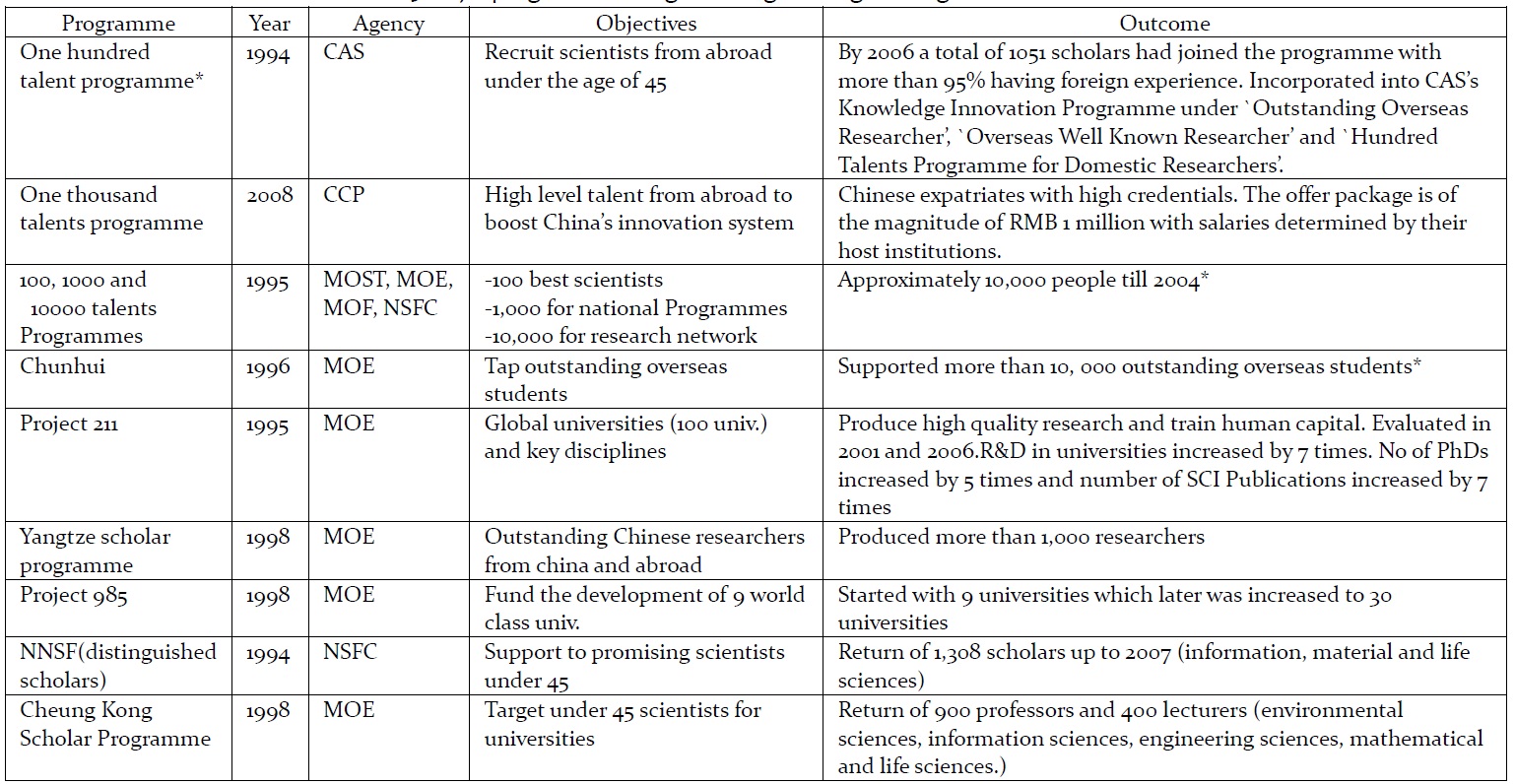
Major programmes for generating and augmenting human resource
2.2. Reforms in Government R&D Institutions
Prior to the opening up of the Chinese economy, the inefficiencies of its public research system stemmed from the problems of research not being linked to industry, poor productivity, lack of links with the industry, etc. The subsequent policies implemented in China have targeted financial appropriation, commercialization, organizational restructuring, and a dual role for Government Research Institutes (GRIs) in research and commercialization. The basic guidelines for revamping the GRIs6 were provided by the 1985 Decision on the Reform of the Science and Technology Management System, the 1995 Decision on Accelerating Scientific and Technological Progress, the Knowledge Innovation Programme (KIP) of 1998, and the Medium and Long- Term Programme of 2006. These have led to a revamp of existing structures, mechanisms and governance.
The ensuing major policy initiatives included taking away assured funding; creating Technology Markets to promote commercialization; bringing in structural changes in the existing institutions on the basis of their activities; providing support through national programmes; sharpening the focus of research institutions through mergers and creating new institutions; making them participate in research in priority fields; making concrete attempts to help them enhance the skill base through several national programmes to attract the best; enhancing commercialization by encouraging them to own or float spin-off enterprises; creating S&T parks; making intellectual property laws favourable to this; consolidation of links among research, academia, and industry; and so on and so forth.
The first step taken in revamping the governance of government research institutions was to discourage the government from providing unconditional funding. The transformation of the GRIs was decided on the basis of their activities related to basic research, public goods, and technical development. Financial appropriations too came to be decided on this basis (Yuan, 2005). Research institutes that were engaged in basic research were offered full budget-based funding. A similar practice was followed in case of public goods R&D institutes. Technical development institutes or applied research institutes were allotted funds only to make up the balance in the beginning. They were expected to procure funding and revenue mainly from technology contracts through vertical or horizontal channels. The number of GRIs declined at an average annual rate of 6.1% from 1999 to 2005 (OECD, 2008). These converted R&D institutes changed their organizational structure from being subordinate to the government to becoming competitive players in the market as independent legal entities. The industrial conversion of R&D institutes engaged in technical development is reported to have resulted in a fundamental structural change in the Chinese S&T infrastructure, greatly enhancing its innovative capacity (Yuan, 2005). The restructuring targeted more than 5,000 GRIs since the 1990s and brought down the number to 3,901 GRIs in 2005. The outcome of this series of initiatives is not just enhanced research outcomes or linkages with the industry but also an ecosystem in which the GRIs have a meaningful role to play. The Chinese Academy of Sciences (CAS) is China's highest academic institute and comprehensive research centre in natural sciences. It is the highest advisory body in China on issues of science and technology, plays an advisory role in the formulation of national S&T strategies and national S&T development programmes, and conducts research on major S&T issues.
Restructuring within basic research institutions in CAS was undertaken to specialize in core areas and strengthen basic research capabilities in the academy. The academy reduced the number of institutions from 122 in 1985 to 91 in 2008. The introduction of reforms and organizational restructuring in CAS has resulted in long-term impacts on the performance of institutes and has led to a productivity growth of 12.5% from 1998-2005 (Zhang, et al., 2011).
2.3. Strengthening the Ecosystem of Innovation
An innovation ecosystem comprises of institutional infrastructure including universities and research institutions, intermediary service providers and the interconnections amongst them. China had a large number of research institutions, universities and production houses prior to reforms, but the system suffered in past from a lack of linkages among innovation actors, deficient intermediary support services, and poor translation of research into applications. Both research institutions and universities were in dire need of transformation. The transformation in these institutions was supported by policies to create an ecosystem which supported the transformation. One such initiative was creation of S&T parks, funding opportunities, creation of intermediary services, so on and so forth, which helped in triggering linkages and improving the ecosystem.
The efforts in transforming these research institutions and universities were accompanied by the efforts in strengthening innovation ecosystem that enhanced the connectivity of elements comprising it. While a number of programmes targeted basic research, applied research and high technology, the Torch programme was launched to target commercialization of research results from universities, GRIs, and high tech industries coming from the major programmes such as programme 863. The Torch programme was launched in 1988 and was expected to connect to the 863 programme which created research outputs in high tech areas such as information technology, biotechnology, new materials, new energy, etc. Through the Torch programme, efforts were made to create an ecosystem that aided and supported the commercialization of research results and to assist manufacturing.
The emergence of an innovation system that became instrumental in creating conditions for aiding innovation has been a part of an organized drive, facilitated by both the centre and the local governments (Hu, 2007). A total of 53 states level Science & Technology Industrial Parks (STIPs) were set up under the Torch Programme emphasizing the high-tech industrialization of China. These have been assisted by both central and state governments through the provision of physical infrastructure, services, and preferential policies such as tax exemptions. Many of these STIPs have high tech innovation centres which keep them dynamic and sustainable. These have achieved high growth rates and have emerged as vibrant clusters by creating industrial aggregation advantages. Statistics suggest an accommodation of 45,828 tenant companies with 5.74 million employees in the parks till 2006, contributing 9% of the total of industrial value added, 5% of the national GDP and a third of the country’s R&D expenditure (Hu, 2007).
These parks focus on declared priority sectors such as information technology, electronics, pharma/biotech, energy, environment, etc. and which have been projected as key areas chosen for promotion in China. The creation of S&T Parks/University Parks/Incubators has facilitated the creation of an ecosystem in China that is conducive to nurturing innovation. The structural reorganization of the university system and public research institutes, and the creation of intermediary structures such as innovation centres, productivity promotion centres, technology transfer centres, venture capital firms, legal services, etc., for supporting commercialization has helped increase dynamism in the Parks. Even though these Parks are not comparable to those of Silicon Valley, they have still managed to create an ecosystem that leverages collaborations. China has enabled its key organizations in academia and government research institutions through a process of gradual transformation to create knowledge and encouraged the creation of production centres from them to offset the limitation of lack of demand from the industry and facilitate the application of knowledge. The varieties of enterprises that have emerged in these clusters are spin offs, affiliated enterprises to universities and research institutes. Some of these have been established by scientists and researchers with privileged access to state programmes on basic research, high technology, and commercialization. These parks also house leading MNCs. The availability of physical infrastructure has contributed to the vibrancy of these parks and to the availability of funding in state-directed programmes along the entire value chain. The focus on select sectors and technologies within the national programmes encouraged competition for funding and consequently to the channelling of research efforts in state directed programmes. The success of S&T/University/Industrial parks has been in providing inter-connections amongst the programmes that focus on high technology and commercialization. The ability to bring together R&D resources residing in CAS, top universities, leading Chinese firms, MNCs and their R&D centres, coupled with the availability of talent in the huge geographical structures has facilitated manufacturing and industrial development.
Regional focus is another important feature of STIPs in China, encouraged by the active participation of local governments. Municipalities have been instrumental in establishing service centres to facilitate technology transfer and commercialization of products; and play an active role in information exchange among innovation actors.They thus assist in commercialization of products. Municipalities have also played an active role in providing resources such as land and finances for developmental work.
Although not all S&T parks have exhibited dynamism, but the most dynamic parks are those which have synergized research, manufacturing and support services. What is noteworthy is the fact that the Chinese initiatives of making changes in the policies and institutions have led to a qualitative improvement in the institutions involved on one hand and also enhanced linkages amongst the actors of innovation on the other. The reforms indicate attempts being made by the state to create a national capacity for developing research, innovation and human resource.
3. Organization and Management of R&D and Technology
The emerging new technologies are multidisciplinary in nature. Their introduction requires high R&D investments, creation of new organizations, advanced skill sets, appropriate regulatory frameworks, vibrant ecosystems, new firms to absorb the new research results, and so on and so forth. In the case of nanotechnology, China has succeeded in bringing about necessary changes in its institutional structures to carry forward the new technology dynamism. Nanotechnology as a field of priority in China surfaced around the beginning of the 1990s. Subsequently, China invested heavily in the development of this technology with massive R&D investments, mobilized advanced skills through creation and repatriation, developed instruments critical for nanotechnology research, emphasized on creating new materials, and also paid attention to the creation of standards, risk analysis, assessment and management centres to encourage wider acceptance of technology, provided funding along the entire chain of innovation, etc (Bhattachrya and Bhati, 2011).
The other important support initiatives are the development of science parks, high industrial zones and university-industry joint research centres, joint technology development, technology transfer, and co-operative partnerships. Identification of new skill requirements not only towards supplying the skill sets but also towards appropriate faculties to create the skill sets has been duly recognized in China. The creation of new organizations for meeting the challenges of emerging technologies in research, academia and industry has also been a very important factor. The process has included both demolishing old structures and creating new ones.
Apart from the promotion of specific technology groups and other support programmes to support domestic industries, China has encouraged the setting up of Chinese standards, the Chinese version of Bayh-Dole Act, and Chinese indigenous innovation policy.
3 Between 2006 and 2010, the Chinese Government targeted having Chinese CPUs in all Chinese supercomputers along with software and electronic devices with participation from universities and firms.
4 http://hothardware.com/News/Chinas-Sunway-BlueLight-MPP-Supercomputer-Skyrockets- On-Most-Powerful-List/
5 Rising tigers sleeping giant: Asian nations set to dominate the clean energy race by outinvesting US, November, 2009, By Breakthrough Institute & the IT & Innovation Foundation, http://thebreakthrough.org/blog/Rising_Tigers.pdf
6 There are three types of Government Research Institutions (GRIs). The first type includes GRIs belonging to the Chinese Academy of Sciences (CAS) and universities which are the main research organizations in China. The CAS, which was founded in 1949, manages 91 research institutes, one university, one graduate school and four documentation and information centres. GRIs under the CAS and universities focused primarily on basic research prior to the S&T reforms that began in 1985. The second type includes GRIs affiliated with ministries. There has been hundreds of GRIs under different industrial ministries, with a focus on applied and developmental tasks related to the field of their own ministries. The third type constitutes GRIs at the regional level. They often carry out R&D relevant to the local requirements of their regions. In 2003, there were 4,169 GRIs nationwide , and 82.4% of them were regional GRIs.
IV. Summing-up and Lessons Dawn for India
China has slowly and systematically narrowed down the scientific gap with developed countries and also overtaken them in certain technology groups. What China has been able to achieve is not merely through increased R&D but also because of a focus on manufacturing and by creating conditions that encouraged learning and leveraging. One of the facets of the Chinese process of institutionalization of policies is the close integration amongst economic, S&T and innovation policies. The success of China lies in creating a physical infrastructure which, along with the necessary transformation in the knowledge residing actors, has been successful in leveraging linkages amongst the actors of innovation. The Chinese innovation plan displays a focus on specialization and has a target of achieving milestones with both a medium and long-term focus. In terms of the lessons that can be learnt from this analysis, the causality of dynamism of S&T in China points at targeted development and commensurate resource mobilization, continuously evolving policies with strict enforcement and implementable instruments, a will to acknowledge failures, and efforts to correct them.
India too has shown impressive achievements when it has targeted and directed development in selected sectors such as space, atomic energy and defence related technological innovations. However, the performance falls below global levels of efficiency in the industrial sector where firms have to face market dynamics. There is no dearth of policies, strategies, and policy instruments but the implementation and regulation requires strengthening. Although many initiatives have been taken in India to boost S&T and innovation, the outcomes can become more visible by following measures that affect the process of building S&T capabilities;
First, India trails behind China in its spending on R&D. India’s expenditure on R&D as a percentage of GDP stood at 0.9% in 2011. In contrast, the figure for China during the same period stood at 1.83%. While the industry dominates R&D in case of China with more than 70% share, the government continues to be the major spender of R&D in India, spending around 3/4th of the total R&D expenditure. There is a need to enhance R&D investments with a focussed and target-centric approach in order to consolidate specific technology sectors. The first and foremost issue in this regard is the need to complement economic policies with suitable innovation policies. This would help build S&T capabilities for a sustainable industrial development similar to the kind attempted in China, Korea, and Japan.
Second, India has not paid the kind of attention to higher education that has been seen in China and Korea. There is a lack of clear and explicit long-term policy perspective on higher education in India (Tilak, 2012). Some of the problem areas are lack of vision, low gross enrolment ratios to higher education, inadequate allocations of public resources to higher education, infrastructure, faculties, research opportunities, and an inadequate number of PhDs in the engineering and software/IT sector (there is a vast gap in the requirements and availability of PhDs). Adequate systemic reforms are required in India to strengthen the education system in general and the higher education system in particular. It would be useful to draw some lessons from China which has tackled this through a number of university upgradation and modernization programmes.
Third, Indian public research institutes in the 1980s suffered from problems similar to China. Although a number of initiatives have been taken in India since the 1980s to enhance their effectiveness, the basic problem is the lack of concurrence between economic and S&T policies. It is extremely important to re-invigorate research institutions that have been created in a wide number of areas. Major structural and organizational changes will enhance their effectiveness and competitiveness on one hand; and create well resourced newer institutions on the other. The need for complementing the existing skill sets in research institutions with newer skills cannot be underestimated. Repatriation of foreign trained Indians has not been strategized in a manner that can help India augment its skill shortages, be it in academia or research institutions.
Fourth, the infrastructure for innovation in India needs to be strengthened. There is a domination of technology generation organizations but these are not supported by adequate organizations to support and promote innovation. Local level support reflects a lack of participation from the local governments. Although a number of initiatives have been taken in the last two decades, these do not match the initiatives undertaken in China. For instance, in India the participation of state governments in developmental projects is mainly in terms of the implementation of central schemes and mobilization of resources. It would be crucial to involve local governments in providing inputs on research and intermediary facilities and hold them responsible with greater stakes. In India, local and regional governments do not have major control except when involved as stakeholders. In contrast, in China, local governments have played a significant role in providing infrastructure and resources such as free land, training of manpower, and support services. Commensurate structural and functional changes are required in the organizations involved in S&T and innovation including the infrastructure for innovation. Given the fact that India has made impressive achievements in sectors which were targeted; and there are systemic problems confronting India’s innovation and higher education system; it becomes imperative to have a target-centric strategic vision that is built on existing strengths, along with the transformation of innovation and higher education system.
Fifth, there is need to strengthen the organization and management of R&D in India. The planning for R&D most often pertains to disbursement of funds to existing institutions with existing manpower which quite often is not even really geared to look beyond compartmentalized disciplines in S&T. The focus is still R&D and its subsequent application towards industrial development is not the mainstay of policies in general. Streamlining, organization, and management of R&D in emerging technologies like biotechnology and nanotechnology requires strong R&D and production synchronization
Sixth, there are sectors which have shown tremendous growth potential such as software/IT, pharmaceuticals, biotechnology, automotives, textiles, etc. These sectors can enable India to achieve global competencies. For instance, Indian software development skills are utilized by foreign global firms for high value added activities but a strategy that can hone Indian strengths for high value added activities by Indian firms is needed. In the pharmaceutical/biotech sector, India has manufacturing strengths and R&D skills residing in firms, research institutions and academia. The need is to look for a niche where India can set global benchmarks supported by R&D. For establishing India on a global map, it is important for the highest growing sectors to be given adequate attention for R&D. It would be important to establish India in at least a few areas where front-runner countries are engaged in R&D, in order to become competitive in the long run. Non-technological means of sustaining innovation alone will not be sufficient. It becomes all the more necessary to direct research as the government is still the major spender for R&D, and thus investments should go to sectors where industry has shown some manufacturing strengths. Though enhancing innovative capacity across a whole range of sectors, institutions, and regions may not be feasible; it is possible to strengthen them selectively through ruthless restructuring—the way that it has been done in China. The strategy for India should therefore target mega programmes, built around sectors where India has built manufacturing strengths and to consolidate them with R&D. Resource mobilisation can be channelized in accordance with targets by reorienting academia, research institutions, and industry to consolidate the ecosystem of innovation.



